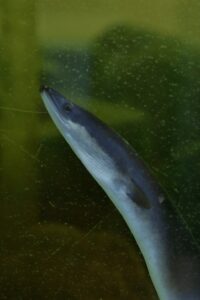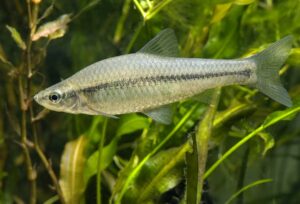Predatory fish : Largemouth Bass or Black bass (Micropterus salmoides)

The Largemouth Bass (Micropterus salmoides), commonly known as Black Bass, is a freshwater fish highly sought after by sport fishermen.
Native to North America, the Largemouth Bass (Black Bass) is now found in many countries around the world, where it is bred in fisheries or introduced into bodies of water for recreational fishing. With its sleek silhouette and large mouth, the Largemouth Bass or Black Bass is a formidable predator that puts up a strong fight when caught.

What is a Largemouth Bass (Micropterus salmoides) ?
The Largemouth Bass (Micropterus salmoides) is a freshwater fish cherished by sport fishermen. Commonly known as the Black Bass, it distinguishes itself with its large mouth and slender body, capable of reaching lengths of up to 60 cm.
Identifying a Largemouth Bass
Physical Characteristics
The Largemouth Bass or Black Bass (Micropterus salmoides) is a powerful and slender fish, equipped with a large mouth filled with sharp teeth. Its head is broad and flattened, with moderately-sized eyes and well-developed gills.
The fins of the Largemouth Bass are short and stout, with coloration ranging from olive green to dark brown on the back, light green to olive on the sides, and a white or cream-colored belly. Males have longer and more pointed dorsal and anal fins compared to females.
| Class |
| Actinopterygii |
| Order |
| Perciformes |
| Family |
| Centrarchidae |
| Genus |
| Micropterus |
| Species |
| M. salmoides |
| Binomial Name |
| Micropterus salmoides (Lacépède, 1802) |
Size and Growth
The Largemouth Bass can reach a maximum size of 60 cm and a weight of 10 kg, although most captured fish measure between 30 and 40 cm, with a weight ranging from 1 to 2 kg. Records for this species can exceed 11 kg for fish raised in fisheries, but in the wild, such specimens are much rarer.
Lifespan and Growth Factors
The Largemouth Bass (Black Bass) can live up to 10 years in the wild, although most captured fish are much younger. The growth of Largemouth Bass depends on various factors, including the environment, food availability, and population density. In nutrient-rich and less-exploited waters, these fish can achieve impressive size and weight in just a few years.
Habitat and Behavioral Patterns
Preferred Habitat
The Largemouth Bass (Micropterus salmoides) is native to North America, where it is widely distributed in rivers, lakes, and ponds. It has also been introduced to many countries worldwide and is appreciated for sport fishing. Largemouth Bass prefers warm and shallow waters rich in aquatic vegetation, such as lakes, ponds, rivers, and marshes. It can tolerate a wide range of environmental conditions but is sensitive to pollution and water quality.
Feeding Habits
The Largemouth Bass (Black Bass) is a voracious predator that primarily feeds on other fish, including Perch, Pike, Roach, and Tench, as well as crustaceans, insects, and frogs. It uses its large mouth and sharp teeth to capture and swallow its prey in one gulp. The diet of the Largemouth Bass or Black Bass varies with its age, size, and habitat.
Reproductive Behavior
Largemouth Bass (Black Bass) reach sexual maturity at around two years of age and can live up to ten years. Reproduction occurs in spring when the water temperature exceeds 15°C. Males build nests on the water bottom using materials such as branches, leaves, and rocks, then attract females by waving their dorsal fins. Females lay their eggs in the nest, and males fertilize them.
The eggs hatch in about a week, and the fry feed on their yolk sacs until they are ready to feed independently. The life cycle of Largemouth Bass is influenced by water temperature and environmental quality. Young fish grow rapidly and reach adult size in two to three years.
The Largemouth Bass in Sport Fishing
The Largemouth Bass (Black Bass) (Micropterus salmoides) is highly prized by sport fishermen for its fighting spirit and ability to prey on various species, making it a challenging catch.
It is also valued for its delicate and flavorful meat, although most anglers prefer to release it after catching. From an ecological standpoint, the Largemouth Bass or Black Bass is considered a keystone species in aquatic ecosystems, as it regulates fish populations and helps maintain the balance of aquatic plant and animal communities.
Techniques for Catching Largemouth Bass
Largemouth Bass or Black Bass can be caught using a variety of fishing techniques, including lures, live baits, and flies. The most popular lures for Largemouth Bass fishing are surface lures like poppers and frogs, which imitate the favorite surface prey of this fish. Fast-retrieving lures, such as spinnerbaits and crankbaits, are also highly effective for catching Largemouth Bass or Black Bass.
Live baits, such as worms and baitfish, are also successfully used for fishing this species. Fishing techniques for Largemouth Bass vary depending on the season, time of day, and fish habitat.
Conservation and Management of Largemouth Bass
The Largemouth Bass (Black Bass) is classified as LC (Least Concern) on the IUCN Red List. The “Least Concern” category indicates that this species is widely distributed and abundant.






